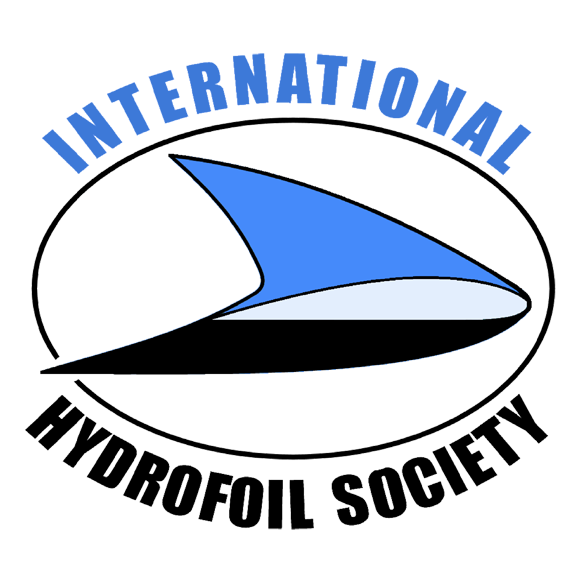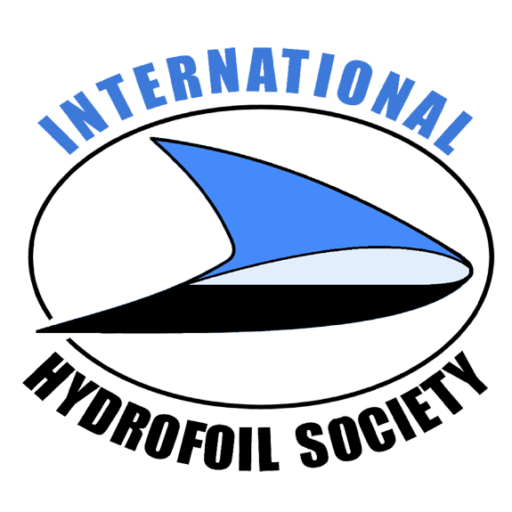| Farcot and Other Inventors The first evidence of the use of hydrofoils on a boat or ship was in a British patent of 1869. It was granted to Emmanuel Denis Farcot, a Parisian, who claimed that “adapting to the sides and bottom of the vessel a series or inclined planes or wedge formed pieces, which as the vessel is driven forward will have the effect of lifting it in the water and reducing the draught.” Source: Hayward, Leslie, “The History of Hydrofoils,” Hovering Craft and Hydrofoils, Vol 4. No. 8 (May 1965) through Vol. 6, No. 6 (Feb 1967). |
 |
||||||
Forlanini
Enrico Forlanini, was an Italian engineer whose interests included airships, aircraft and helicopters. His hydrofoil developments started in 1898 with a series of model tests from which he arrived at several simple mathematical relationships. These allowed him to proceed with the design and construction of a full scale craft. Forlanini’s designs were characterized by a “ladder” foil system. You can see from a drawing of his concept and a copy of an old photograph what is meant by this aptly named ladder foil. Forlanini’s model experiments had shown him that lift was proportional to the square of speed, therefore less foil area was required as speed increased. He conveniently obtained this decrease in foil area with the ladder scheme. The craft weighed about 2,650 pounds and had a 60 hp engine driving contrarotating airscrews. Although designed to fly at a speed of 56 mph, records, according to Leslie Hayward, show that during tests on Lake Maggiore, Italy in 1906 a speed of 42.5 mph was obtained. Although the foil system was a rather complicated structure, Forlanini’s craft operated well and represented an advancement in the state of the art. He obtained a number of British and American patents on his ideas and designs, most of which were aimed at seaplane applications. |
(91k) |
(7k) |
|||||
| Guidoni and Croco — Guidoni, in the 1910 to 1921 time frame, was involved in the development of hydrofoil seaplanes. He mounted foils beneath the floats of seaplanes to reduce the impact loads and improve the landing characteristics of such craft in rough water. The aircraft Guidoni worked with usually became airborne at well below 50 knots. According to Leslie Hayward Hayward’s article “The History of Hydrofoils,” Hovering Craft and Hydrofoils, Vol 4. No. 8 (May 1965) through Vol. 6, No. 6 (Feb 1967), Guidoni’s work was based on that of Croco, who in 1907 experimented with marine craft supported by simple monoplane dihedral foils, but had little success in applying them to flying machines. Guidoni’s ladder foil system was finally successful in executing the first take-off and landing of a hydrofoil seaplane in 1911. This was because he adopted Croco’s dihedral foil feature, which avoided the sudden transition from one foil to the other under varying speed conditions. More information about Croco. |
 |
 |
|||||
 |
 |
||||||
| HYDRODROMES (HD-4) AGB Museum’s HD-4 Gallery – A product of Alexander Graham Bell and Frederick Walker (“Casey”) Baldwin, this 60-foot long craft set a world speed record of 70.85 miles per hour in 1919. |
 |
||||||
| CAPT Richardson’s Dinghy — It was about 1909 that a young “Naval Constructor” Holden C. Richardson fitted a set of submerged foils to a dingy. Under tow, Richardson’s dinghy took off and flew at six knots on a river in Philadelphia. He was one of the few Naval officers who believed that hydrofoils could be applied to practical seagoing craft during the period when the US Navy had written them off despite the success of Alexander Graham Bell and Casey Baldwin’s HD-4 Hydrodrome. CAPT Richardson’s early interest was inspired, in part, by Forlanini; they both were interested in using hydrofoils as landing gear for seaplanes. In Richardson’s experiments, his craft was fitted with a set of foils consisting of a fixed ladder foil forward and a controllable foil aft. The incidence angle and the foil tips could be manually controlled. Roll control, banking into a turn, and maneuverability were achieved by this foil tip control, much in the same way as warping of aircraft wing surfaces was done during that time period. Richardson’s efforts in hydrofoil supported craft continued until about 1911. in that year he received a patent for a speed boat powered by twin air propellers with controllable fore and aft fully submerged foils. | |||||||
| Baron von Schertel More informationModel VS-8 |
VS-6 (45k) |
 VS-8 |
|||||
| Picture awaited VS-10 |
Picture awaited Torpedo Boats |
||||||
| Tietjens Professor Oscar Tietjens, another hydrofoil pioneer, patented a surface-piercing hoop foil system that was first tested on a small speed boat at Philadelphia in 1932 (the 500 lb. craft reached a speed of about 25 mph with only a 5 hp outboard motor). Tietjens later returned to Germany, where he continued his development work in parallel with Baron von Schertel. The VS-7 hydrofoil, a 17-ton craft with a hoop foil system, was built in Schleswig, Germany at the Vertens Yacht Yard. The VS-7 was built to the same displacement and had the same power as von Schertel’s VS-6. Although the VS-7 attained a speeds up to 55 knots compared to the 47 knots of the VS-6, the stability and maneuverability of Tietjen’s hydrofoil was much poorer than that of the VS-6, and had difficulty with takeoff. |
(45k) |
 (15k) |
|||||
 (29k) |
 (24k) |
||||||
| One of the five hydrofoils TS1-5 which had a displacement of 6.3 tons laden. | (19k) |
||||||
| GrunbergWsevolode Grunberg, a Russian National living in France, conceived a submerged foil system that featured a single main lifting foil with forward floats or surface riders. These planing floats adjusted the angle of attack of the main foil, controlled foil submergence, and provided roll stability. Models of the craft, shown here in a sketch, were tested in the Saint-Cyr model basin in France. In the late 1930s, Grunberg came to the USA at the invitation of the National Advisory Committee for Aeronautics (NACA) to demonstrate his hydrofoil design principle. NACA’s interest was in possible application to seaplanes. Mr. Grunberg worked as a French citizen, providing design information so that a model could be built and tested at Langley, VA. In one of the ironies of wartime, classification of the project prevented Grunberg, a foreign citizen, from seeing the results of the model tests. Grunberg later became a US citizen, changing his name to Waldemar Craig. It wasn’t until years after World War II, when all interest in hydrofoil landing gear for seaplanes had ceased, that Mr. Craig found out how really successful the NACA model tests had been. |  |
||||||
| Hydrofin with an airscrew. It was taken in Cowes, England about 1949. Christopher Hook is at the controls. Icarus , a later model |  (150k) |
||||||


